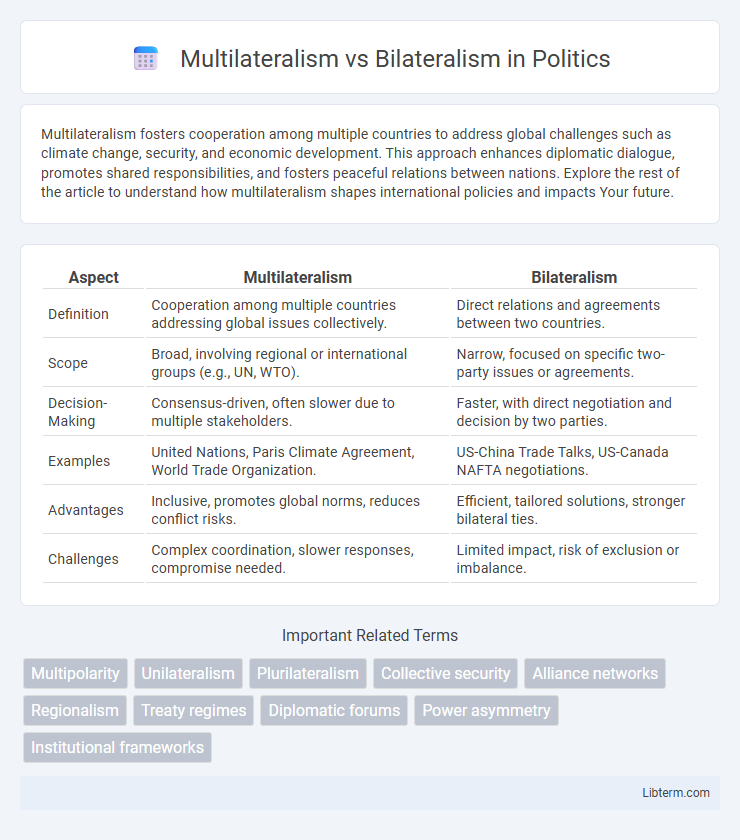Multilateralism fosters cooperation among multiple countries to address global challenges such as climate change, security, and economic development. This approach enhances diplomatic dialogue, promotes shared responsibilities, and fosters peaceful relations between nations. Explore the rest of the article to understand how multilateralism shapes international policies and impacts Your future.
Table of Comparison
| Aspect | Multilateralism | Bilateralism |
|---|---|---|
| Definition | Cooperation among multiple countries addressing global issues collectively. | Direct relations and agreements between two countries. |
| Scope | Broad, involving regional or international groups (e.g., UN, WTO). | Narrow, focused on specific two-party issues or agreements. |
| Decision-Making | Consensus-driven, often slower due to multiple stakeholders. | Faster, with direct negotiation and decision by two parties. |
| Examples | United Nations, Paris Climate Agreement, World Trade Organization. | US-China Trade Talks, US-Canada NAFTA negotiations. |
| Advantages | Inclusive, promotes global norms, reduces conflict risks. | Efficient, tailored solutions, stronger bilateral ties. |
| Challenges | Complex coordination, slower responses, compromise needed. | Limited impact, risk of exclusion or imbalance. |
Introduction to Multilateralism and Bilateralism
Multilateralism refers to the practice of multiple countries working collaboratively on common issues, emphasizing global cooperation through international organizations such as the United Nations and the World Trade Organization. Bilateralism involves direct relations and agreements between two countries, focusing on negotiated treaties or partnerships to address specific interests like trade, security, or diplomacy. Both frameworks play crucial roles in shaping international relations, with multilateralism fostering collective action and bilateralism enabling tailored cooperation.
Historical Evolution of Diplomatic Approaches
Multilateralism emerged prominently post-World War II with institutions like the United Nations and the Bretton Woods system fostering collective decision-making among multiple states. Bilateralism, rooted in traditional diplomacy, emphasizes direct negotiation between two states, reflecting earlier European diplomatic practices such as the Concert of Europe in the 19th century. Over time, the shift toward multilateralism corresponds with globalization and the complexity of international issues requiring broader cooperation beyond individual state interests.
Core Principles of Multilateralism
Multilateralism is founded on principles such as inclusivity, cooperation among multiple states, and adherence to international rules to address global challenges effectively. It emphasizes equal participation, collective decision-making, and shared responsibility to achieve common goals, contrasting with bilateralism's focus on direct relationships between two states. Core principles include respect for sovereignty, non-discrimination, and transparency in negotiations to foster trust and stability in international relations.
Fundamentals of Bilateralism
Bilateralism centers on direct interaction between two sovereign states focused on mutual agreements and cooperation tailored to their specific interests, often emphasizing trade, security, or diplomatic relations. This approach fosters clear communication channels and swift decision-making, enabling precise negotiation outcomes without third-party influence. Bilateral agreements typically offer flexibility and customization, reflecting the unique political, economic, and cultural ties between the involved countries.
Key Differences between Multilateralism and Bilateralism
Multilateralism involves cooperation among three or more countries, creating frameworks like the United Nations or World Trade Organization to address global issues collectively. Bilateralism centers on direct agreements between two nations, facilitating targeted negotiations and tailored treaties such as trade agreements or defense pacts. The key difference lies in the scope and complexity of engagement, with multilateralism promoting broad collaboration and bilateralism enabling focused, specific partnerships.
Advantages of Multilateral Agreements
Multilateral agreements foster collaboration among multiple countries, enhancing diplomatic relations and promoting global stability through shared commitments. These agreements facilitate comprehensive solutions to transnational issues like climate change, trade regulations, and security by pooling resources and expertise. They also reduce the risks of unequal bargaining power, ensuring more balanced and inclusive decision-making among nations.
Benefits and Limitations of Bilateral Relations
Bilateral relations offer the benefit of tailored agreements that directly address the specific interests and needs of the two involved parties, enabling faster decision-making and stronger diplomatic ties. These relations, however, face limitations such as reduced influence in addressing global issues compared to multilateral frameworks and the risk of imbalance if one party holds greater power. The focused nature of bilateral agreements can hinder cooperation on broader international challenges, limiting the scope and effectiveness of solutions.
Case Studies: Multilateralism in Action
Case studies like the Paris Agreement and the World Trade Organization exemplify multilateralism's capacity to address global challenges through collective action involving multiple countries. These frameworks enable coordinated policy-making on climate change and trade by fostering cooperation, shared responsibilities, and consensus-driven decisions among diverse nations. Multilateralism's advantage lies in its ability to create comprehensive, scalable solutions that bilateral agreements often cannot achieve due to their limited scope and participants.
Case Studies: Successes and Challenges in Bilateralism
Bilateralism has demonstrated significant successes in international relations, as evidenced by the U.S.-China Phase One Trade Deal, which facilitated targeted negotiations and specific commitments on intellectual property and agriculture. However, challenges such as limited scope and dependency on political will often hinder bilateral agreements, exemplified by the India-Pakistan bilateral talks that repeatedly stall due to deep-seated mistrust and conflicting national interests. Case studies highlight that while bilateralism allows for tailored and flexible diplomacy, its effectiveness is constrained by the absence of broader multilateral frameworks that provide enforcement and collective pressure.
Future Trends: The Balance between Multilateralism and Bilateralism
Future trends indicate a nuanced balance between multilateralism and bilateralism shaped by geopolitical dynamics and economic interests. Multilateral institutions like the United Nations and World Trade Organization will continue fostering global cooperation, while powerful states may prioritize bilateral agreements to secure strategic advantages and faster outcomes. The interplay between global challenges such as climate change and trade tensions will drive nations to selectively blend multilateral frameworks with bilateral partnerships for optimized diplomacy and economic growth.
Multilateralism Infographic

 libterm.com
libterm.com